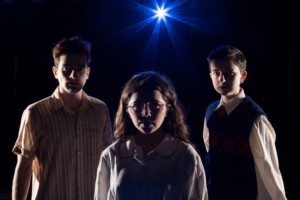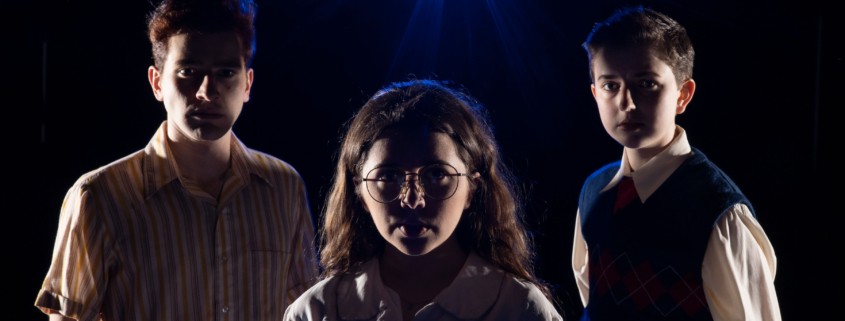A WRINKLE IN TIME tessers audiences at local stages
Meg saved the world again last week in East Lansing, Michigan.
Michigan State University’s theater department transformed an intimate stage into Camazotz for the occasion, bringing to campus a stage adaptation of A Wrinkle in Time.

Photo Courtesy of Michigan State University.
This was a book-lover’s show: a tribute to the story and its truth, not a high-tech reproduction of detail-by-detail world-building.
“The reader is very present in this adaptation,” said A Wrinkle in Time director Ryan Welsh, assistant professor of theatre at Michigan State. Student actors reading copies of the Newbery Award-winning book step into and out of the imagined reality playing out on stage. Sometimes the actor-readers narrate when internal thoughts make the action go silent. Parts of this adaptation is right from the novel, dialogue verbatim.
“The cast is comprised of readers that are living in 1962 and they crack open this book and it’s through their collective conjuring of their imaginations that the story comes to life,” he said.
Tracy Young adapted the novel for the Oregon Shakespeare Festival about five years ago. The script is available through Stage Partners, along with a few other adaptations, each one suited to different cast sizes, audiences, and other needs. (To read or download the script, see Stage Partners’ Wrinkle in Time page here.) Theater troupes from Seattle Pacific University to a community group in Australia will perform Young’s play in the next year.
In Michigan State’s production, the audience had an intimate spot. Every scene from the Murrys’ house to Camazotz and back were performed in a round, and entering the theater was an immersion in the production before it even began.
A man in a red flannel shirt swept a part of the stage, surprising some of us by later playing Fortinbras the dog, among other roles. A student sat at a stool, reading from a big book. A woman held up paint swatches to a pillar in the corner of the stage, then “painted the wall” with a dry brush. A boy dressed like a teen from the ‘60s bounced a basketball just off stage; a woman lingered by the stove.
All this happened while audience members were finding seats, using the restroom, finishing snacks. Unless one was paying attention, the cast’s comings and goings could be mistaken for the normal comings and goings of an excited crowd.
Eventually, they all settled in scattered spots around the room, reading copies of A Wrinkle in Time. The lights dimmed; the play began.
How do you create a magical, otherworld on stage (without the budget behind, say, The Cursed Child)? Welsh used the “sandbox idea”: they used what they had and let imaginations take over the rest. The narrative was entrancing enough. The movement-driven, ever-changing ensemble cast made the play soar. Somehow, the low-key components — Aunt Beast, the act of tessering, even IT — were more engrossing because they lacked flashiness.
When they needed a dog, one of the actors crouched with an origami-looking dog’s head in one hand. When they needed to convey tessering, lights did the heavy lifting. A white sheet became the Brain. Best, most convincing, was Charles Wallace under IT’s power. Inspired by a Japanese dance theater move called Butoh, his shoulders, neck, knees all moved in odd, jerky, horrific ways, amping up the terror for the audience.
My copy of A Wrinkle in Time suggests that readers be 10 or older; the play had the same recommendation. Though Wrinkle is considered children’s literature, Welsh said he didn’t want to do a play for kids. Instead, his philosophical approach was to let the actors create an illusion that would let the audience’s imaginations take over.
Welsh, who has a film background, said he knew the danger of adapting a well-loved book for the stage — especially this one, what he called the “grandmother of young adult fiction.”
“There’s so much credit owed and due to that book,” he said. So he didn’t want to simply tell the story; he wanted the audience to join actors on the adventure.
A Wrinkle in Time on stage “invites (the audience) to engage with it in order for (the story) to feel valid, magical and special and all the things we want it to feel,” he said. Magical and special aren’t usually words reserved for grown-up theater, but Welsh said they should be.
“(We adults are) so wrapped up in the grind that we forget how to fantasize,” he said. This adaptation says, “Come, imagine with us, in a similar way a book does.”
I felt that permission to let my imagination romp around during the production. Right after landing in the twins’ vegetable garden, right before the cast bows, a small, holy spell hung in the air. Meg may have saved the world, but the audience? We tessered right with her.
— Erin F. Wasinger, for MadeleineLEngle.com.

 Michigan State University
Michigan State University
